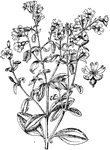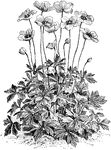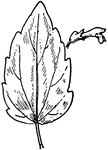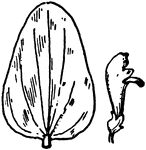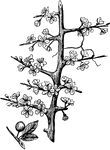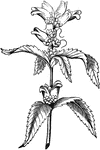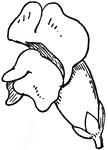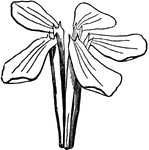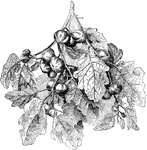437 illustrations of flowers and shrubs including: sabatia, safflower, saffron, sage, sainfoin, saltbush, sassafras, saururus, saxifrage, sedge, sesame, shad scale, shamrock, shooting star, skullcap, sloe, snakeroot, snapdragon, sneezeweed, snowberry, soapwort, sorrel, spurge, squash, St. John's wort, star of Bethlehem, starflower, stonecrop, strawberry, sumac, sundew, sundrops, and sunflower

Silene Pennsylvanica
Longitudinal section of flower of Silene Pennsylvanica, showing stipe between calyx and corolla.
Silique
"Silique, the fruit of certain cruciferous plants, consisting of a pair of valves which seperate from…

Simarouba
"Branch of Simarouba amara, with female flowers. a, a male flower; b, a female flower." -Whitney, 1911
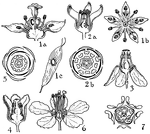
Orders of Simarubaceae, Burseraceae, Meliaceae, and Malpighiaceae
The orders of simarubaceae, burseraceae, meliaceae, and malpighiaceae are pictured. The flowers of these…
Simple cyme
Diagram of a simple cyme in which the axis lengthens, so as to take the form of a raceme.
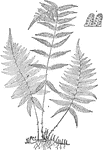
Dryopteris Simulata
Species of plant belonging to the Dryopteris, a large and widespread genus of medium terrestrial ferns.

Flower of Single Garden Petunia
In the single varieties of petunia there is variety in coloring. Some are beautifully veined, striped,…
Sisal Hemp
Sisal or sisal hemp is an agave Agave sisalana that yields a stiff fiber used in making rope. (The term…
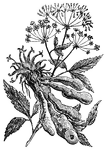
Skirret
Sium sisarum. "A species of water parsnip, generally said to be of Chinese origin, long cultivated in…
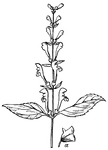
Skullcap - Upper Part of the Flowering Stem
"A plant of the genus Scutellaria: so called from the helmet-like appendage to the upper lip of the…

Common Skullcap
Of the Mint family (Labiatae), the leaf of the common skullcap (Scutellaria galericulata).
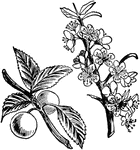
Sloe
A shrub of the plum family, usually frowing to a height of from six to twelve feet. Its wood is hard…
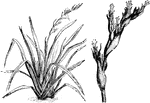
Small Flax Lily
Small flax lily is the common name of phormium cookianum. The flowers are yellow with greenish outer…

Smilax
"Stem of "Smilax" (Myrsiphyllum). l, scale-like leaves; cl, cladophyll, or leaf-like branch, growing…
![Smilax is a genus of about 300-350 species, found in the tropics and subtropics worldwide. In China for example about 80 are found (39 of which are endemic), while there are 20 in North America north of Mexico[1]. They are climbing flowering plants, many of which are woody and/or thorny, in the monocotyledon family Smilacaceae, native throughout the tropical and warm temperate regions of the world. Common names include catbriers, greenbriers, prickly-ivys and smilaxes. "Sarsaparilla" (also zarzaparrilla, sarsparilla) is a name used specifically for the Jamaican S. regelii as well as a catch-all term in particular for American species. Occasionally, the non-woody species such as the Smooth Herbaceous Greenbrier (S. herbacea) are separated as genus Nemexia; they are commonly known by the rather ambiguous name "carrion flowers"](https://etc.usf.edu/clipart/57000/57029/57029_smilax_mth.gif)
Smilax
Smilax is a genus of about 300-350 species, found in the tropics and subtropics worldwide. In China…
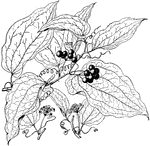
Hispida Smilax
Plant native to South Africa, featuring rich folliage that is commonly used for decorations.
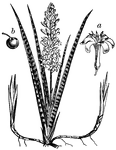
Snake Plant
Sansevieria Zeylanica is the Latin name, but this plant is also called a Mother-in-law's Tongue. "A…

Snakenut
"Germinating seed of Ophiocaryon paradoxum. a. radicle; b. cauliculus; cc. cotyledons." -Lindley, 1853

White Snakeroot and Boneset
Of the Composite family (Compositae): left, white snakeroot (Eupatorium urticaefolium); right, boneset…

Maryland Black Snakeroot
Of the Parsley family (Umbelliferae), the Maryland black snakeroot (Sanicula marilandica).

Maryland Black Snakeroot
"Flowering plant of sanicle (Sanicula marilandica). (a), a male flower; (b), the fruit." -Whitney, 1911

Seneca Snakeroot - Roots and Base of the Stem
"Polygala senega of eastern North America. It sends up several stems from hard knotty root-stocks, bearing…
Seneca Snakeroot - Stem and Flowers
"Polygala senega of eastern North America. It sends up several stems from hard knotty root-stocks, bearing…
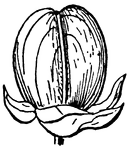
Seneca Snakeroot - the Fruit
"Polygala senega of eastern North America. It sends up several stems from hard knotty root-stocks, bearing…

Snapdragon
"The snapdragon catch-fly, showing tiny insects caught upon the sticky band of the stems." -University…

Snapdragon
"2. corolla of Antirrhinum majus cut open; 3. its pistil; 4. its ripe fruit; 5. cross section of its…

Small Snapdragon
Of the figwort family (Scrophulariaceae), the small snapdragon (Antirrhinum Orontium).
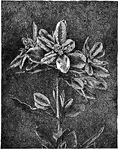
Snow-on-the-Mountain
Snow-on-the-mountain and ghost weed are the common names of euphorbia marginata. It is native from the…
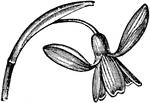
Snowdrop
Snowdrop is the common name for members of the genus Galanthus, a small genus of about 20 species in…

Soapberry
"Sapindus senegalensis. 1. an expanded flower; 2. a petal; 3. the ovaries before fertilisation; 4. a…
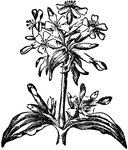
Soapwort
"Soapwort (Saponaria), a genus of plants of the natural order Caryophyllaceæ; so called because…
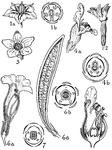
Orders of Solanaceae, Scrophylariaceae, Bignoniaceae, and Pedaliaceae.
Pictured are flowers of the orders solanaceae, scrophulariaceae, bignoiaceae, and pedaliaceae. The flowers…

